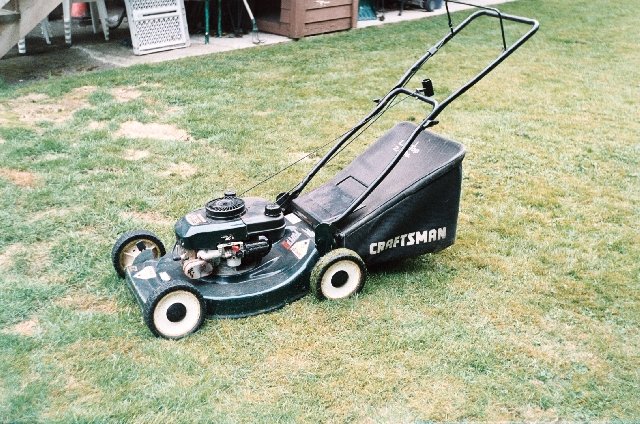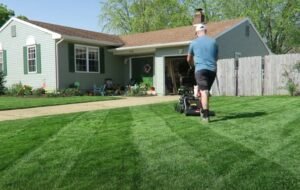We're an affiliate
We hope you love the products we recommend! Just so you know, we may collect a share of sales or other compensation from the links on this page. Thank you if you use our links, we really appreciate it!
What is a Lawn Mower and How Does it Work?
Lawn mowers are machines that are designed to cut grass. They come in a variety of shapes and sizes, but they all have one thing in common – they make it easy to cut the grass.

Lawn mowers work by rotating blades that cut the grass. The blades can be powered by a motor that runs on electricity or gasoline.
You can get a lawn mower that you push with your own power. There are also lawn mowers that will propel themselves (known as self-propelled mowers). Then there are the lawn mowers you can ride (they are called riding mowers, duh!). Finally, there are robot lawn mowers that don’t require much work from you after the original set up.
How to Cut Grass with a Lawn Mower in 5 Easy Steps
1. Walk the yard and pick up any sticks, trash or other objects before even starting the mower.
2. Use a string trimmer to trim
3. Set the height of your lawn mower’s blade to cut at a desired height (usually 3 inches).
4. Start the mower and begin pushing the mower around the outside edge of the area you want to mow
5. Mow the area using one of the patterns described in the next section
Mowing Patterns for a Healthy Lawn
The best way to maintain a healthy lawn is to mow it in different patterns. Mowing your lawn in the same pattern every time will eventually lead to a dead, brown, and unhealthy looking lawn.
Many people will mow the outline of the area they are going to mow and then repeat the pattern moving closer to the center with each pass. However, most professional lawn care companies use a horizontal, vertical and diagonal pattern that changes with each mow.

Horizontal: The horizontal pattern is easy to do. After you mow the edges of the area you are going to mow, you simply mow from one side of the edge to the other. Then, turn the mower around and mow back the other way. Continue that pattern until you reach the opposite end from where you started.
Vertical: The vertical pattern is like the horizontal pattern except you will mow from front to back. Start at the edge of your outline and make one pass along the edge. Turn the mower around and make another pass. Continue on until you reach the opposite edge from where you started.
Diagonal: Mowing diagonally makes your lawn look like a professional did it. After mowing the edges of the biggest part of your yard, start at a corner of the outline and cut a diagonal swath to the opposite corner.
Now you have basically two triangles of unmown grass. You can make a pass on one triangle and the next pass you can move to the other triangle. I prefer to mow one triangle until it is complete, then move to the next triangle.
Contoured: The contoured pattern will follow the contours of a land scape and maintain that for the entire mow.
To Mulch or Not to Mulch that is the Question
Mulching grass clippings with leaves can be an effective way to keep your garden healthy and free of weeds. The clippings will help to keep the soil moist and the leaves will provide nutrients to the soil.
A mulching mower will chop the grass clippings up into very small pieces and drop them back onto the lawn. The clippings are so fine you won’t notice them.
Most lawn mowers are equipped with the capabilities of bagging the grass clippings, mulching the grass clippings or discharging the grass clippings out of the side discharge port.
Generally speaking, I no longer use the side discharge option on my mower. I will either mulch or bag. Here is how to decide when it is better to mulch.
- After an application of fertilizer or weed killer. If you bag your clippings, you will carry away some of the nutrients you just put down. I will typically mulch my clippings for at least two mows after any kind of lawn treatment.
- If there is no place to put the bags of grass clippings. If you have a compost pile this will solve that problem. You might even have access to a service that will come by regularly to pick up your yard waste.
- If you have a healthy lawn that is free of weeds.
- If you want to chop up leaves in the fall.
Here is how to decide when it is better not to mulch.
- When the grass is too tall. Mulching mowers will get clogged up and bogged down when trying to chop up to many grass clippings at once.
- When the yard has a lot of weeds. Mulching will only spread the seeds around the yard and make matters worse than before.
- When the grass is wet. Like tall grass, the mulching mower can’t mulch wet grass very easily because the water makes it too heavy to chop up.
Safety First
Some safety practices to keep in mind when using a lawn mower include:
- Do not override any safety feature on the machine. These features evolved over a long period of time and usually were brought about by multiple incidents of serious injury.
- Wearing sturdy shoes to avoid slipping and falling.
- Making sure the mower is turned off and disabled before putting your hands under the cutting deck. For electric mowers, unplug the cord or remove the battery. For gas mowers, disconnect the spark plug.
- Keeping children and pets away from the mower while it is in use. Flying debris can cause injury
- Not attempting to mow in wet conditions. Even with good shoes, wet grass can be slippery.
- Wear eye protection to protect your eyes from flying debris and dust.
How to Perform Maintenance on Your Lawn Mower After Every Use
As a homeowner, you need to make sure that your lawnmower is in good condition and that you are performing maintenance on it after every use.
- Inspect under the mowing deck. Make sure there isn’t a build up of grass that is stuck to the underside of the deck. This will make the mower less efficient. It will disrupt the mulching process. And the wet grass decompose and start to corrode the deck.
- Check the oil level. Top it off if necessary
- Clean the air filter periodically. This is probably only needed once or twice a mowing season.
- Visually inspect the entire mower to ensure everything is in good working order. If you find something with unusual wear, replace it.
Conclusion
In conclusion, using a lawn mower to cut your grass is a great way to save time and get the job done right. By following these simple steps, you can be on your way to having a beautifully manicured lawn in no time.
